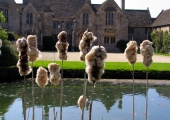.
Natural History: Water
In the Hundred of Bradford on Avon, Wiltshire
.

Aquatic plants at Barton Bridge; the tiny floating duckweed is a plant of still water and only develops on the River Avon when the flow is very slow, when the river is ponded by the weir at Avoncliff in summer
.
The Bradford on Avon Hundred area -the town of Bradford on Avon and its surrounding villages- has a fairly wide variety of aquatic and damp habitats. The River Avon and its tributaries flow through the area, providing slow and fast moving environments, with extremes when there is flooding. The Kennet & Avon Canal also crosses the area, with slightly flowing water, disturbed only by passing barges. Some lakes and small ponds, not as common as they once were, give still and sometimes stagnant conditions. The overall alkalinity of this limestone country prevents the occurrence of acidic bogs.
The river is lined with willows, alder and blackthorn. Purple loosestrife, amphibious mustard and the invasive non-native himalayan balsam
Grey herons are common and usually very tame, kingfishers are often seen even in the centre of the town, cormorants are becoming common, much to the annoyance of anglers and egrets are now frequently spotted. Mallard, black-headed gulls, herring gulls and lesser black-backed gulls are very common; mute swans nest beside the Town Bridge in most years; moorhens; coots are found on still water, but sometimes on river and canal, the little grebe or dabchick similarly occurs on lakes.
Water voles do occur and sometimes an otter; a sea lion at Avoncliff was an escapee; grass snakes may be seen swimming in the river in the town; common toads frequent ponds in gardens and countryside.
Winsley Parish Council cares for a small pond at Little Ashley -see a page on the Winsley website.







